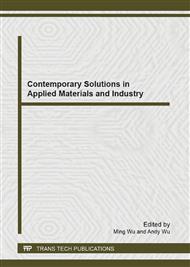p.131
p.137
p.141
p.145
p.149
p.157
p.161
p.166
p.172
Synthesis of Chitooligosaccharide-Selenium and its Antioxidant Activity In Vitro
Abstract:
The objective of this study was to synthesize a new organic selenium compound, chitooligosaccharide-selenium (COSSe), and evaluate its antioxidant abilities on hydroxyl radicals, super oxide radicals and DPPH in vitro. Sodium selenite and chitooligosaccharide (COS) were used to synthesize COSSe by chemical method. The yield was 37.26% and the content of selenium (Se) was 9.02mg/g. COSSe was characterized by ultraviolet (UV) and infrared (IR) techniques. The results proved the successful synthesis of COSSe. The antioxidant activities on hydroxyl radicals, super oxide radicals and DPPH of COSSe were investigated. The results showed that antioxidant activities were concentration related in the setting concentration range and the antioxidant effects of COSSe were totally better than that of COS. The scavenging rates on hydroxyl radicals, superoxide radicals and DPPH of 2.5mg/mL COSSe were 71.19%, 64.54% and 69.78%, respectively. This research provides a possible application of COSSe as a low toxic and effective organic Se-enriched healthy product.
Info:
Periodical:
Pages:
149-153
Citation:
Online since:
April 2013
Authors:
Price:
Сopyright:
© 2013 Trans Tech Publications Ltd. All Rights Reserved
Share:
Citation:


